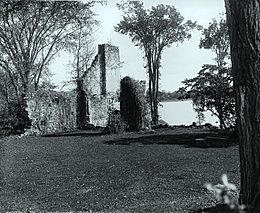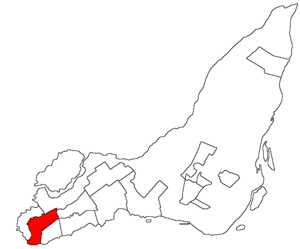Fort Senneville facts for kids
Quick facts for kids Fort Senneville |
|
|---|---|
| Part of Montreal's outlying forts | |
| Quebec, Canada | |

Fort Senneville in 1895
|
|
| Type | Castle-like fort |
| Site information | |
| Controlled by | New France |
| Condition | Some ruins remain |
| Site history | |
| Built | 1671 |
| Built by | Séminaire de Saint-Sulpice |
| In use | 1671-1763 |
| Materials | Stone, wood |
| Demolished | 1776 |
| Battles/wars | Iroquois incursions American Revolution |
Fort Senneville is an old fort near Montreal, Quebec, Canada. It was built in 1671 by the French settlers of New France. The land was given to Dugué de Boisbriant in 1672 by the Society of Saint-Sulpice. A big stone windmill was built there in 1686. It was also a watch tower and looked like a castle with special features to defend it. The Iroquois burned the fort in 1691, but the windmill survived.
In 1692, Governor-General Louis de Buade de Frontenac ordered a stronger fort to be built. It was rebuilt again in 1702–1703 to protect a nearby place where people traded furs. This fort had many cannons and was the strongest castle-like fort near Montreal. In 1776, Benedict Arnold destroyed the fort during the American Revolutionary War. Today, some ruins of the fort still stand. In 2003, it was named a historic site.
Why Forts Were Built

French explorers helped New France cover a large area in North America. However, fewer French people lived there compared to the English colonies nearby. So, the French king sent engineers to build strong forts. These forts would protect the French settlements.
One saying about the colonies was:
In the new colonies, the Spanish start by building a church, the English a tavern, and the French a fort.
The city of Quebec was the only truly fortified city in the Americas. It had a strong central fortress called the Citadelle of Quebec. Montreal had a different defense plan. It had about 30 smaller forts built around it. These forts protected against constant attacks from the Iroquois people.
Most of these forts were simple wooden fences called stockades. But some were built like strong manor houses in France. About four of these were large stone forts. They were like "true castles" and helped stop Iroquois attacks.
The First Fort
Fort Senneville was first a French stockaded fort. It was built in 1671 near the Sainte-Anne rapids. The land was given to Dugué de Boisbriant in 1672. Later, it went to Jacques Le Ber and Charles Le Moyne. They used the site as a place to trade furs.
A large stone windmill was built on a hill by 1686. It also worked as a watch tower. From there, people could see the Ottawa River, the Lake of Two Mountains, and the Des Prairies River. This windmill was special. It had thick walls and square holes for muskets. It also had "machicolation" at the top. This allowed defenders to drop hot liquids or rocks on attackers below.
In October 1687, the nearby Fort Sainte-Anne and the Senneville mill were attacked by Iroquois. Some settlers died, but the attackers were pushed back. A second attack happened in 1691. This time, the fort was burned down. Only the stone windmill was left standing.
The Second Fort
The attack in 1691 happened after the Battle of Quebec (1690). Governor-General Louis de Buade de Frontenac was very angry. He ordered a second, stronger fort to be built. The fort was rebuilt in 1692. It had thick stone walls and strong corner towers called bastions. With many cannons and swivel guns, it was the "most substantial castle-like fort" near Montreal.
After this, the fort was never attacked again. The windmill was rebuilt in 1700. It was probably used until the 1780s. In 1703, Jacques Le Ber de Senneville built a large stone house and fort. This helped him improve and protect his fur trading. A local manor house was built in 1706. After New France fell in 1763, the British did not use the fort for military purposes.
In 1776, Fort Senneville was destroyed. This happened during the American Revolutionary War. Continental Army troops led by Benedict Arnold destroyed it. This was part of military actions around the Battle of the Cedars.
In 1865, John Abbott, a former prime minister of Canada, bought the property. He used it as a summer home. Later, Sir Edward Seaborne Clouston bought the land in 1898.
Fort Senneville Today
The site of Fort Senneville is still private property. The area is about 10 acres. It is an important part of Montreal's history and nature.
In November 2003, Quebec recognized its historical importance. It was named a "Site historique". The Ministry of Culture and Communications has studied the fort's history. They have also funded archaeological digs and repairs. This helps keep the ruins strong. They know the site has "exceptional historic and prehistoric archaeological potential."
The site is also important for its environment. Its shoreline is very natural. It is a habitat for the rare map turtle. The fort is located between the Lake of Two Mountains and the Senneville Forest. It is considered a wildlife corridor between the lake and the forest.
See also
 In Spanish: Fuerte Senneville para niños
In Spanish: Fuerte Senneville para niños


